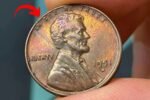This 1944 Wheat Penny with No Mint Mark is Extremely Rare
Every coin tells a story, but some coins tell stories worth thousands—maybe even millions. One of those rare coins is the 1944 Wheat Penny with no mint mark. While most people think of pennies as just pocket change, this particular coin is far from ordinary. It’s a small copper piece with big value and a unique history that has surprised coin collectors and casual finders alike.
Many of these rare coins still turn up in coin jars, old drawers, or as loose change. That’s why coin experts say it’s worth taking a closer look at your pennies—especially those from 1944.
$2,500 Cash App Class Action Settlement 2025, Check Payment Date & Status
What is a 1944 Wheat Penny?
The Lincoln Wheat Penny, also known as the Wheat Cent, was minted from 1909 to 1958. It features the profile of President Abraham Lincoln on the front and two wheat stalks on the back. The 1944 version is one of the more common years—over 1 billion were made.
But here’s where it gets interesting. Most 1944 pennies were made of copper and stamped with a mint mark—“D” for Denver or “S” for San Francisco. However, a small number were minted without any mint mark at all.
The absence of a mint mark means it was produced at the Philadelphia Mint, which often didn’t use mint marks during that period. While most of these Philadelphia coins were normal, some had unique errors or were made using the wrong metal, making them extremely rare and highly valuable.
Overview Table: 1944 Wheat Penny with No Mint Mark
| Feature | Description |
|---|---|
| Coin Name | 1944 Lincoln Wheat Penny (No Mint Mark) |
| Mint Location | Philadelphia |
| Material Used | Mostly Copper (but some rare Steel ones) |
| Known Rare Error | Steel planchet instead of Copper |
| Estimated Value | $5,000 to over $100,000 (if rare error) |
| Key Feature | No Mint Mark + Wrong Metal |
Why This Coin is So Valuable
The regular 1944 Wheat Penny isn’t very rare on its own. Millions were made. But the 1944 penny with no mint mark made from steel is what collectors are searching for.
Here’s why it’s valuable:
-
Wrong Material Used – In 1943, pennies were made of steel coated in zinc to save copper for the war. In 1944, they went back to using copper. But a few leftover steel blanks accidentally got used in 1944.
-
Extremely Rare – Only a few dozen steel 1944 pennies are known to exist from the Philadelphia Mint. That makes them very valuable, especially in mint condition.
-
Historical Significance – These coins reflect a wartime manufacturing mistake, adding a rich backstory that appeals to collectors.
-
No Mint Mark – Most rare coins from this year were found with a “D” or “S” mint mark. Finding one with no mint mark and made of steel is like winning the coin collector’s lottery.
How to Identify a Rare 1944 Wheat Penny
So how can you tell if your 1944 penny is rare?
Here are some things to check:
-
Check the Date: It must say 1944 on the front of the coin.
-
Look for a Mint Mark: If there’s no letter under the date, it’s from Philadelphia.
-
Test with a Magnet: Use a household magnet. If it sticks, it’s made of steel, not copper.
-
Check the Weight: A copper penny weighs about 3.11 grams, while a steel one is around 2.7 grams.
-
Don’t Clean the Coin: If it looks old or dirty, leave it. Cleaning it can lower its value.
If your coin fits these conditions, especially if it’s a steel 1944 no mint mark penny, get it checked by a professional coin dealer or grading service right away.
Frequently Asked Questions (FAQs)
Q1. Why are some 1944 Wheat Pennies valuable?
A1. Most are not, but a few rare ones were mistakenly made from steel instead of copper. These error coins are extremely rare and can be worth thousands.
Q2. How can I tell if my 1944 penny is steel or copper?
A2. Use a magnet. Steel pennies will stick, while copper ones will not. Also, steel pennies are lighter in weight.
Q3. What does it mean if there is no mint mark?
A3. No mint mark means the coin was made at the Philadelphia Mint, which didn’t use mint marks in 1944.
Q4. How much is a rare 1944 steel penny worth?
A4. Depending on its condition, a 1944 steel penny without a mint mark could be worth anywhere from $5,000 to over $100,000.
Q5. Where should I take my penny to be checked?
A5. You can take it to a certified coin dealer, a coin grading company like PCGS or NGC, or a coin show for a professional evaluation.
Check Your Coins Before Spending
Most of us have loose change lying around the house. But imagine spending a penny worth tens of thousands of dollars because you didn’t know what you had. That’s why stories of rare coins, like the 1944 Wheat Penny with no mint mark, continue to grab attention.
It’s easy to overlook a coin that looks old or rusty, but that could be the exact coin collectors are searching for. People have found valuable coins in old piggy banks, car cup holders, and even vending machine trays.
It’s worth taking a moment to look through your change. You never know—you could be holding a rare piece of American history.
Conclusion
The 1944 Wheat Penny with no mint mark is one of those rare treasures hiding in plain sight. While most of them are common copper coins, the steel versions with no mint mark are incredibly rare and valuable. Whether you’re a coin collector or just curious, it’s worth checking your pennies—you might be holding a tiny fortune without knowing it.
If you find a 1944 penny that sticks to a magnet and has no mint mark, don’t spend it. Get it checked—you could be the next person with a $100,000 coin in your pocket.
Some Important Link
| Telegram Group | Click Here |
| WhatsApp Group | Click Here |
| Home Page | Click Here |














